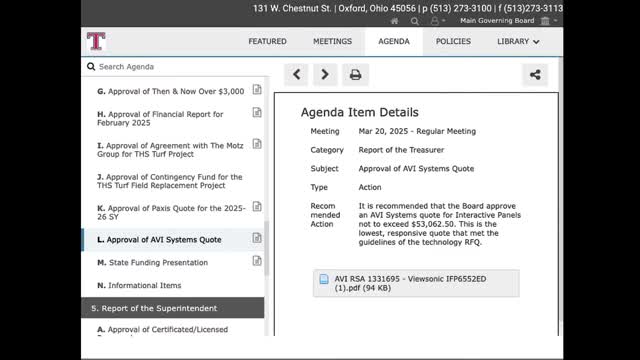Education funding update reveals Ohio's shift towards local taxpayer reliance
March 21, 2025 | Talawanda City, School Districts, Ohio
This article was created by AI summarizing key points discussed. AI makes mistakes, so for full details and context, please refer to the video of the full meeting. Please report any errors so we can fix them. Report an error »

During the Talawanda Board Meeting on March 20, 2025, significant discussions centered around the state funding for education, highlighting the challenges faced by local schools in Ohio. The meeting featured a detailed presentation on the current state funding formula, known as the Fair School Funding Formula, which is under review as part of the governor's biennium budget proposal.
A key takeaway from the presentation was the reliance on local funding sources, such as property taxes and school district income taxes, which account for 76% of the district's educational funding. This heavy local dependency contrasts sharply with the state’s contribution, which has decreased from 26% to an anticipated 11% if the proposed budget is approved. This shift raises concerns about the sustainability of public education funding in the district, as local taxpayers are increasingly shouldering the financial burden.
The board discussed the implications of the funding formula, which is designed to assess each district's ability to raise funds based on property and income levels. However, the formula's complexity and reliance on outdated data points have led to disparities in funding. For instance, the local capacity to generate revenue is influenced by property valuations that do not account for significant tax-exempt properties, such as those owned by Miami University, further straining the community's financial resources.
Additionally, the meeting addressed the growing concern over the state's voucher program, which allows families to use public funds for private school tuition. The board noted that a substantial portion of state funding is directed toward this program, with reports indicating that families earning significantly above the poverty line are benefiting from these vouchers. This has sparked a debate about the fairness of public funds being allocated to private education while public schools face budget cuts.
In conclusion, the discussions at the Talawanda Board Meeting underscored the urgent need for community engagement and advocacy regarding education funding. The board encouraged residents to attend an upcoming community forum to learn more about these issues and to voice their concerns to state legislators. As the landscape of education funding continues to evolve, the board remains committed to ensuring that public education remains accessible and equitable for all students in the district.
A key takeaway from the presentation was the reliance on local funding sources, such as property taxes and school district income taxes, which account for 76% of the district's educational funding. This heavy local dependency contrasts sharply with the state’s contribution, which has decreased from 26% to an anticipated 11% if the proposed budget is approved. This shift raises concerns about the sustainability of public education funding in the district, as local taxpayers are increasingly shouldering the financial burden.
The board discussed the implications of the funding formula, which is designed to assess each district's ability to raise funds based on property and income levels. However, the formula's complexity and reliance on outdated data points have led to disparities in funding. For instance, the local capacity to generate revenue is influenced by property valuations that do not account for significant tax-exempt properties, such as those owned by Miami University, further straining the community's financial resources.
Additionally, the meeting addressed the growing concern over the state's voucher program, which allows families to use public funds for private school tuition. The board noted that a substantial portion of state funding is directed toward this program, with reports indicating that families earning significantly above the poverty line are benefiting from these vouchers. This has sparked a debate about the fairness of public funds being allocated to private education while public schools face budget cuts.
In conclusion, the discussions at the Talawanda Board Meeting underscored the urgent need for community engagement and advocacy regarding education funding. The board encouraged residents to attend an upcoming community forum to learn more about these issues and to voice their concerns to state legislators. As the landscape of education funding continues to evolve, the board remains committed to ensuring that public education remains accessible and equitable for all students in the district.
View full meeting
This article is based on a recent meeting—watch the full video and explore the complete transcript for deeper insights into the discussion.
View full meeting
